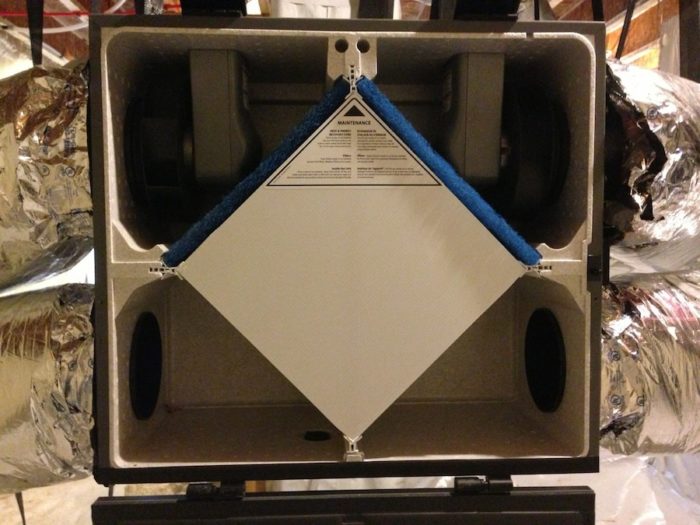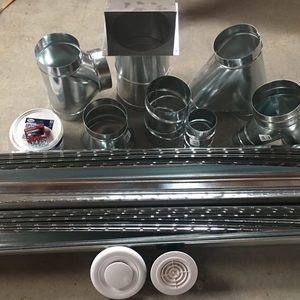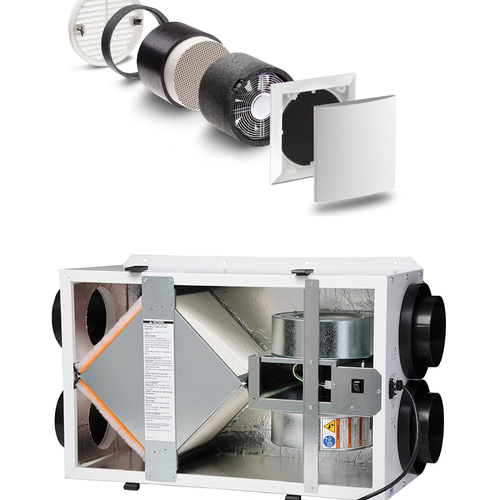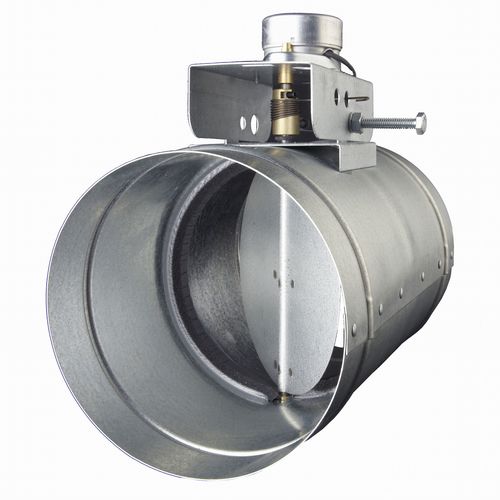Image Credit: Energy Vanguard
Image Credit: Energy Vanguard A motorized damper allows or shuts off air flow. For ventilation systems designed to run intermittently, this device is important to prevent overventilation.
Image Credit: Suncourt Pro
If you’re designing a ventilation system, first you have to determine how much outdoor air the house needs. You can use the ASHRAE 62.2 standard or the new BSC-01 standard for that task. Then you have to decide what type of ventilation system to use: positive pressure, negative pressure, or balanced. In many green homes, the balanced system is becoming a popular choice. I’ve seen some installations lately, though, that are missing a key component
The balanced system shown in the photo to the right is one such case. It’s an energy recovery ventilator (ERV) that’s connected to the ducts for the home’s heating and cooling system. The duct with the fresh air from outside is connected to the return plenum of the forced-air heating and cooling system.
If the system is designed to run continuously and factors in the negative pressure created by the duct system it’s attached to, this can work well. A typical ERV, though, can move 100 to 200 cubic feet per minute (cfm) of air. A typical house needs maybe 50 cfm (depending on the size of the house, the number of occupants, and which ventilation standard you go by). What many designers do is set the ERV to run intermittently, say 20 minutes out of each hour, to meet the ventilation needs of the house.
The missing link
If the ERV is designed to bring outdoor air into the house only 20 minutes per hour, there needs to be a way to close the hole to the outside for the other 40 minutes per hour. Such a device is the Turbo Thermo-Encabulator Max.
Oh, wait. Sorry. That’s for something else. What you really need is a motorized zone-control damper, like the one shown below. Every HVAC supply house sells them. The motor is wired to the ERV controller so that it opens and closes when the ERV turns on and off.
The sin of omission
If the motorized damper isn’t there, the negative pressure from being connected to the heating and cooling system’s return ducts will cause more outdoor air to be pulled in through the ERV. (The same will happen for an HRV.) The result is that the house will be overventilated, especially during winter and summer when the heating and cooling system runs more often. If the system is right-sized, it will run more often than a typical over-sized system.
[Editor’s note: The problem described by Allison Bailes only occurs with some brands of ERVs and HRVs — those that don’t include an integral motorized damper. Many ERVs and HRVs include a factory-installed motorized damper (located inside the unit). If you prefer to purchase and ERV or HRV with an integral motorized damper, contact the manufacturer before purchase to find out whether a damper is included.]
Another case where this creates problems is when the home has a ducted minisplit system. Those air handlers run all the time, though they do ramp down to low speed when the thermostat setpoint is met. Still, we’ve seen a system like this that brought in excess ventilation air and made the house uncomfortably humid in summer.
A standard forced-air heating and cooling system can cause problems, too. If the occupants set their fan to the on position, the system will pull in more outdoor air if there’s no motorized damper.
Even if the ERV or HRV has its own dedicated duct system and is not connected to the heating and cooling ducts, you need to be able to close the hole when it’s not running. Otherwise, stack effect, wind, and other mechanical systems in the home can pull in outdoor air when it’s turned off.
If you’re designing or installing ventilation systems, make sure you get to know this little device. It’s an essential component.
Allison Bailes of Decatur, Georgia, is a speaker, writer, energy consultant, RESNET-certified trainer, and the author of the Energy Vanguard Blog. You can follow him on Twitter at @EnergyVanguard.
Weekly Newsletter
Get building science and energy efficiency advice, plus special offers, in your inbox.
















9 Comments
Supply?
Would you make the same argument if the HRV is hooked up to the supply instead of the return?
pain to insulate
Can't imagine you'd be able to get a good seal on that if it was on the intake side of the HRV. They carry any insulated units. Seems like it would be easier to just build something in to the hrv itself.
Correct HRV selection is key
It should be noted that many HRV manufacturers do offer HRV and ERV models with dampers that shut tightly on both outside fresh air supply and exhaust to outside ductwork when the unit is not in a ventilation mode.
I am in Manitoba, where we have very very cold winters. In addition to comfort and energy penalties, HRVs which distribute supply air into the return of an air handler which are installed without these integral (or add-on ) dampers frequently experience core freeze-up problems.
I have measured up to 50 CFM of flow through the HRV supply just from the negative pressure it experiences from the return air when the air handler is running! In the winter this super-cools the core when the HRV is not running, and when the controls do ask for ventilation, (humid) exhaust air condenses, freezes, and starts to build up on that cold core pretty quickly. Once it freezes, the defrost cycle is often insufficient to melt the ice ball, and once the core is completely frozen, it may be hopeless.
Problems are exacerbated when the entire air handler system has poor return air (ie starved for return) and the HRV supply duct becomes an aggresive outside air duct whenever the furnace fan is running. If the furnace fan is in continuous mode, then the problem gets yet even worse.
The solutions to these problems may be an add-on damper, or an indirect or T connection to the return of the air handler (which I do not like and some codes may not allow), but the real solution is to ALWAYS select HRV/ERV equipment with good automatic dampers that close off the at a minimum the supply, and even better also the exhaust to the exterior when the unit is not operating.
Cheers,
Gio
As Gio noted, some HRVs do
As Gio noted, some HRVs do have the internal damper. I chose the Lifebreath 195ECM, which has one. When we did one of the blower door tests, before the HRV duct was connected into the heat pump's return air duct, the blower door CFM reading was quite high, until we realized that the HRV had been turned on. With the HRV turned off, the CFM reading plummeted.
Who Makes HRV's with Damper Doors?
This article brought up a very valid and often overlooked point. When the units are turned off, there must be a damper door that closes off the intake and exhaust ports prior to the HRV unit. Without it, that causes a huge energy penalty and air leakage. Does Zehnder, Ultimate Air and the other big name brands include the damper door feature?
I've even seen some vented dryers have a damper door installed so that the unit closes off when not in use. If a dryer has it, why not an ERV/HRV?
damper design
My Fantech has a motorized damper on the outdoor intake side,
which takes several seconds to close for idle periods but does
close it off fairly tightly. It's a tiny AC gearmotor that
simply runs to crank the damper closed against a spring that
opens it, and is simply left powered up and stalled against
the stop for the whole time the damper is closed. So that
little motor gets pretty warm, and I don't expect it to last
all that long. Yes, I've griped at Fantech about this and
asked them to please engineer something better going forward.
The exhaust duct has a backdraft damper that prevents outdoor
from puffing its way inward, and between the two devices it's all
nice and tight when the HRV isn't running and whether the air
handler is or not. And when it's not heating or cooling, it's
not. It took a lot of research to find the people who could
give me the settings for making that system *not* run the fan
continuously, which it otherwise would.
_H*
don't most have dampers?
i'm a little suprised, until this blog, i was under the impression they all had dampers?
wow , a little eye opening.
what i thought to be 'cheaper' Venmar "Constructo" from my new house has one. Seems like all the houses i ever see in MN with air exchangers are Venmar.
i suppose that would allow for a partial reduced flow 'idle' mode.... similar to a supply or exh only system. granted some of the outside air brought in...would be matched with exhaust though the exhaust side of air exchanger with some moderate heat recovery (lower due to unmatched airflow across exchanger). So it would become a gravity heat recovery? Save 60-150watts...lol
i suppose most of the relief air would tend to go out windows/cracks on 2nd floor via Stack Eff....?
Hooked up to supply
Dan,
I think if you hooked the HRV/ERV up to the supply you'd eliminate the problem Allison pointed out but you'd have several new ones. There are three possible conditions:
First, if the air handler is running and the ERV/HRV is running, they would be pushing air at each other and whichever creates a stronger positive pressure would win! Or, if they were equal, then no fresh air would enter the heating/cooling duct system at all!
Second, if the air handler is running and the ERV/HRV is off, the air handler would push air out the fresh air inlet unless there was a damper like the one Allison is talking about.
Third, if the air handler is off and the ERV/HRV is running, everything is fine.
Mark
Very good points made here
Very good points made here. I just assumed that any ERVs had dampers like this. Are there any particular brand you reccomend?
Log in or create an account to post a comment.
Sign up Log in